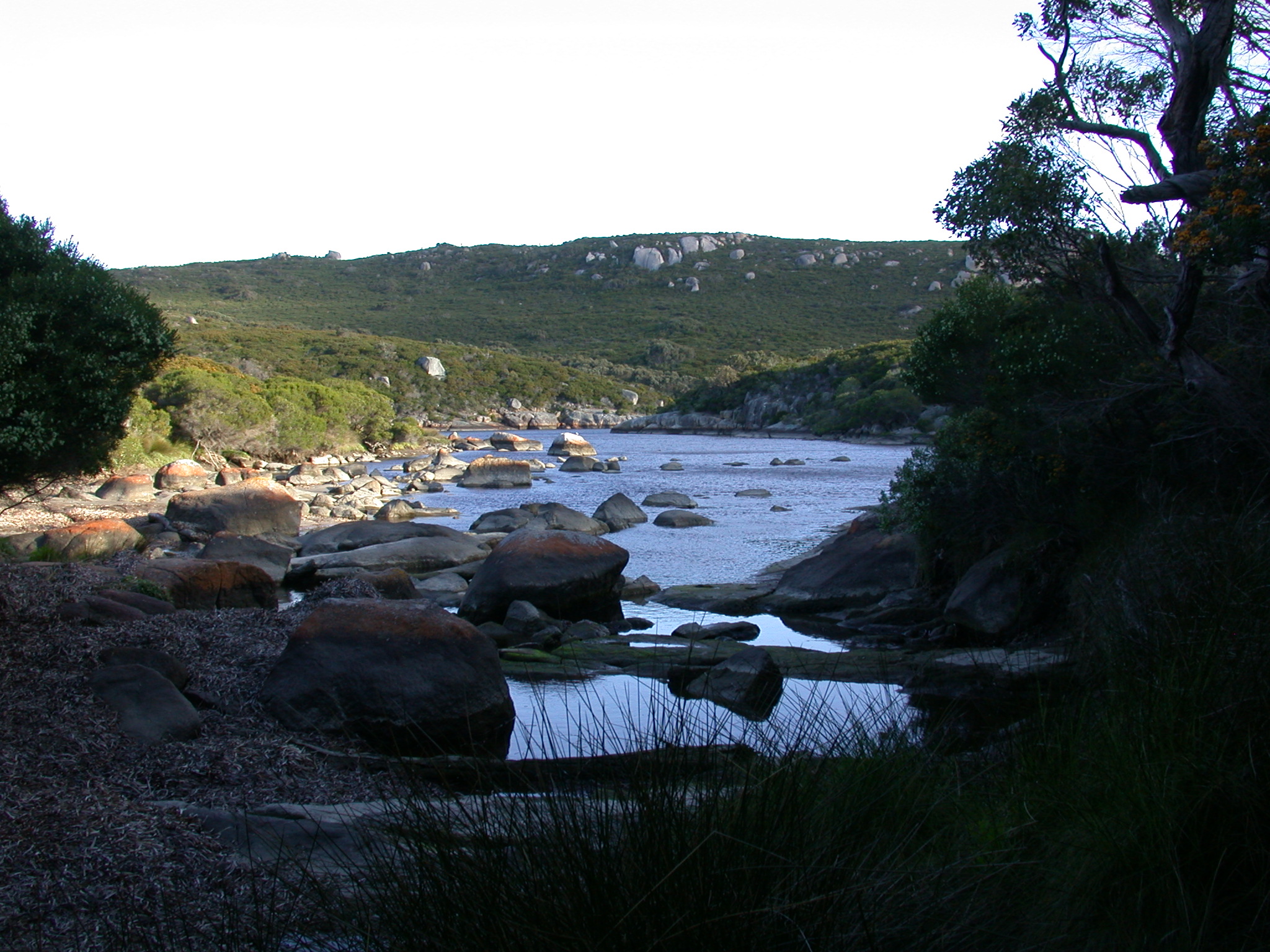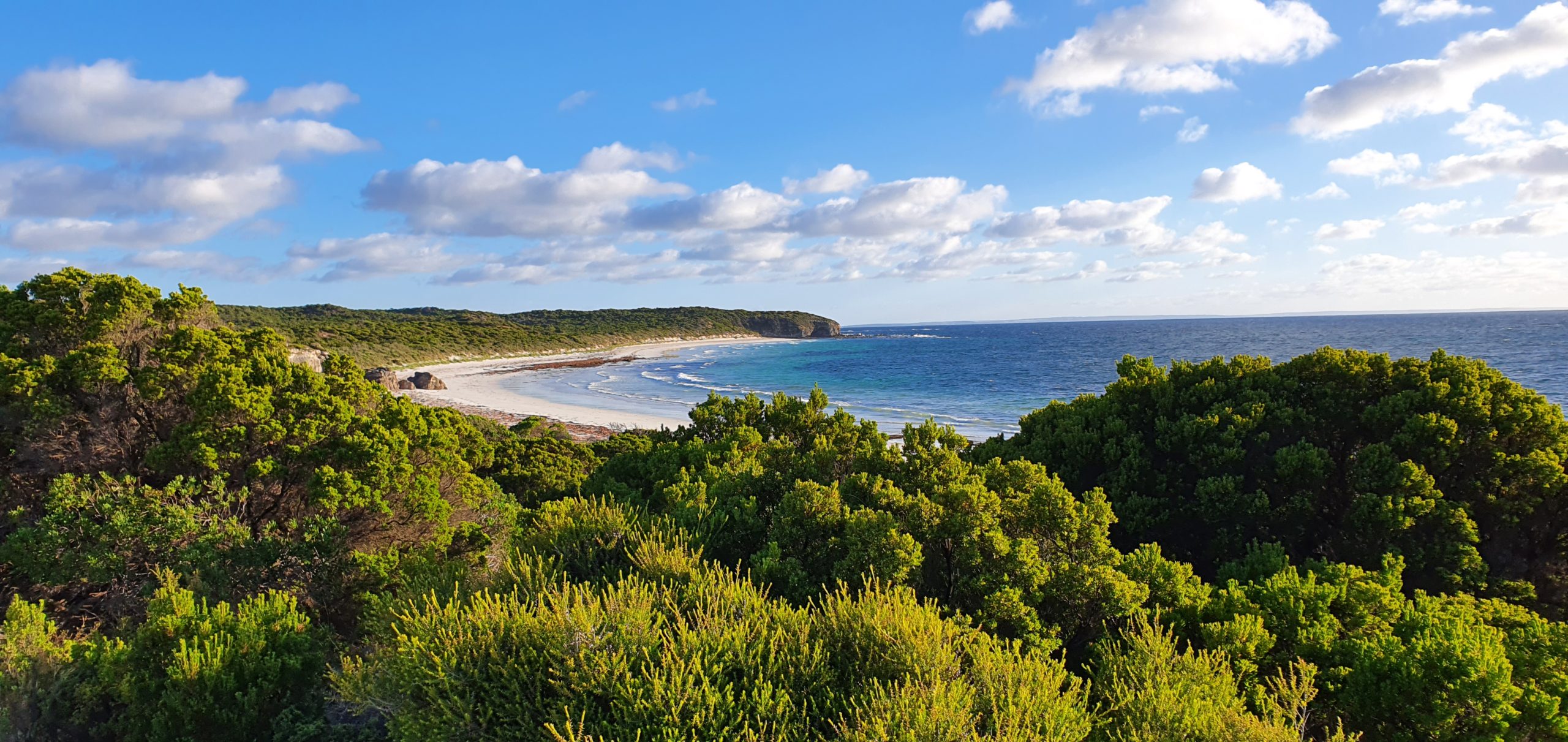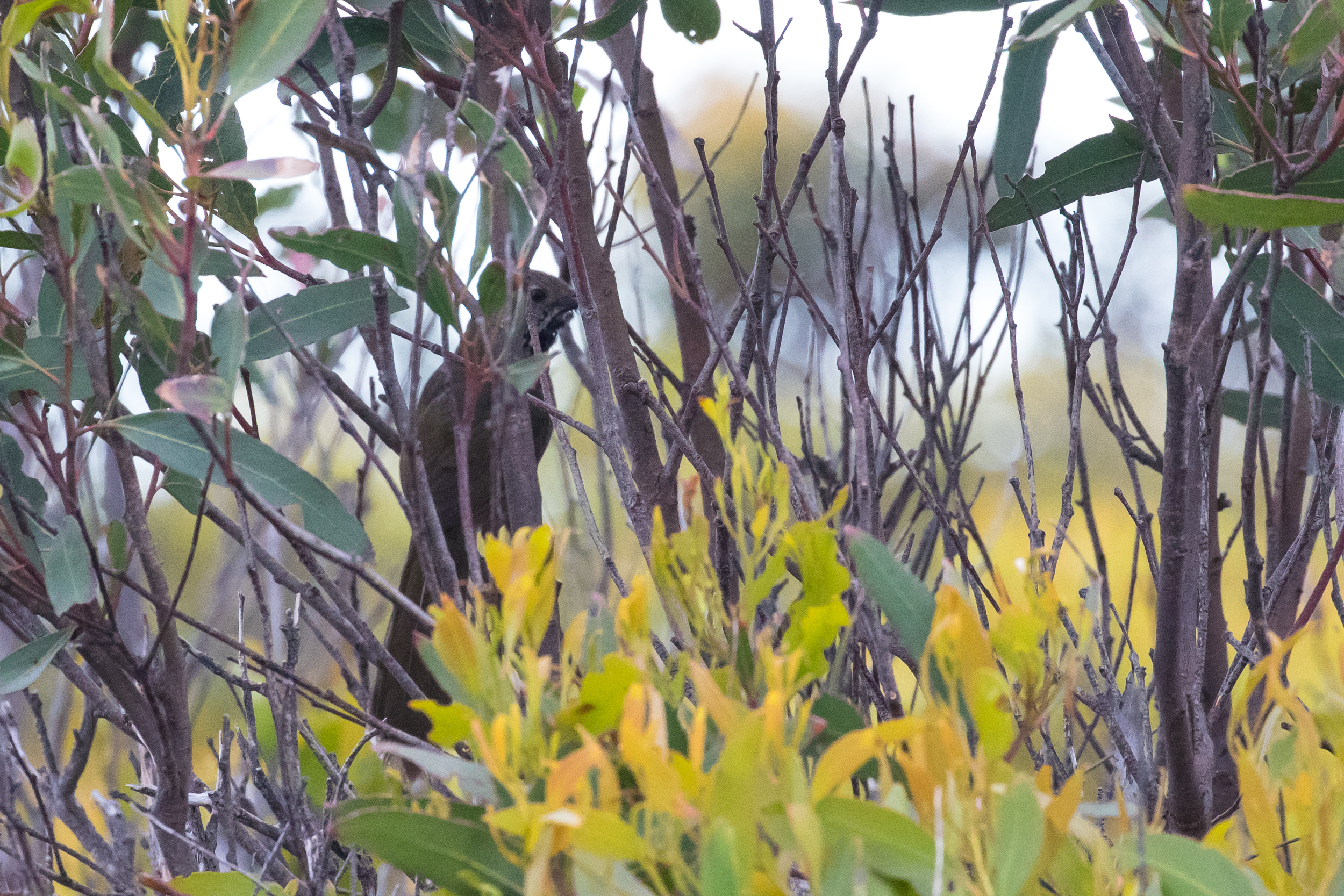Western Whipbird is one of the so-called BIG THREE of south-west WA birding, the other two being Western Bristlebird and Noisy Scrub-bird. All are scarce and isolated to small parts of the rugged and beautiful, southern coast near Albany. And all three are buggers to see, being notorious skulkers. This makes them all the more desirable!
Noisy Scrub-bird was rediscovered in the 1960s at Two People’s Bay, 25km east of Albany; formerly thought extinct from around the turn of the century, a population of about 40 birds was found in 1961 and through careful management and translocation programs the population had recovered to a still small but more viable total of around 500 by the mid-1990s. Cheyne Bay, 100km further east, was one of the translocation sites and since it also supports good populations of both the Bristlebird and the Whipbird, it became the go-to place for visiting birders hoping to land all of the SW endemics.
My first and only attempt to see the WA big three was in 2004. We were living in Perth for 3 months visiting UWA colleagues while I was on sabbatical from Oxford, when I snuck a spring weekend trip in to Cheyne Bay. On my flying visit, I stayed in the caravan park at the beach (as most birders do) and had one full day birding a further dawn. I managed to find Western Bristlebird in the heath above the caravan park, and I heard Noisy Scrubbird at the nearby and very beautiful Waychinicup National Park, but failed to see one. I cannot actually remember if I even heard the third of the skulkers, Western Whipbird.

Cheyne Beach 
Waychinicup National Park
Unlike the Bristlebird and Scrubbird, which are endemic to WA, the Whipbird is also found in a few places in SA – mostly coastal heathlands, but also apparently a small population hangs on in the mallee in Ngarkat. So living in SA might give me a crack at this member of the trio, at least.
In fact it wasn’t for many more years that I got another shot, with a couple of days camping in Oct 2017 with my daughters in Innes National Park at the tip of the Yorke Peninsula, about 3.5 hrs drive from Adelaide. Though the trip mostly revolved around cliff-top walks admiring the wild and spectacular coastline, and long strolls along the stunning mostly deserted beaches, I spent the two early mornings before breakfast searching unsuccessfully for Western Whipbird. Again I have little recollection of even hearing a bird. It was here that the bird began to acquire a more mythical status as a major bogey for me, and also where Louisa coined its nickname, Walnut Whip-bird, to taunt me.

The next spring I returned for a reprise of the trip, this time with Louisa and a friend of hers, but came away with a distant heard-only record, my sole reward for another couple of early rises.
And then in January 2019 we had a family holiday on Kangaroo Island. While camping in Flinders Chase NP I did the dawn rise thing again and had a very loud, very close, but ultimately invisible encounter with a Whipbird near Remarkable Rocks. So far I was scoring 0 from 6, perhaps my worst ever record for one bird.
Come December 2020, as a cost-saving measure, the University closed one week earlier than usual before Christmas, forcing all staff to take leave-without-pay. Loath to waste this leave on the back of a year largely devoid of travel, Nikki and I hastily arranged a few days for the family (including my Mum and Dad visiting from Perth) on Kangaroo Island. Here was a new opportunity finally to crack this particular (wal)nut. By now, though, Western Whipbird had been split by IOC into Black-throated (the WA variety) and White-bellied Whipbird, making this SA’s third endemic species after Chestnut-breasted Whiteface (see report here) and Short-tailed Grasswren (Wren blog here). Fuck-knows who came up with the name, since it manifestly does not have a white belly. It has a slight greyish smudge on its belly, but even this seems to me to be smaller than the corresponding smudge on the Black-throated split. Both species have a Black-throat. WTF?? White-bellied itself comprises two races, leucogaster, which is the mainland variety found primarily at the southern tips of Eyre and Yorke peninsulas, and lashmari, a sub-species endemic to KI.
Our ferry trip over to KI was enlivened by regular consultation of cricinfo as the Indian batting collapsed at Adelaide Oval. Having been to the match the previous two days, I was disappointed not to be there for this defining session; as we boarded the ferry the score was 1/15. By the time we were disembarking it was 9-36 and as we drove away from the terminal Shami was hit on the arm and retired hurt; all out for 36! At our lovely holiday rental on Nepean Bay we watched the Aussies knock of the runs for an unexpected win, then turned our attentions to exploring the property; a Hooded Plover scuttled about distantly on the shore of the private beach, an Echidna foraged on the roadside by the property’s driveway, a dozen or so Tammar Wallabies emerged into the garden, Jupiter and Saturn were almost conjoined in the west, and as the sky darkened the Milky Way lit up above us.





Our first morning, 20th Dec, I was up at sparrow-fart (actually quail-fart – one was singing in the field behind our holiday rental in Nepean Bay) and drove eagerly on the unsealed roads from the north to south of the island, arriving at Gantheaume Conservation Park around 7am. The January bushfires had burnt out 50% of the island including 98% of Finders Chase NP in the west, and killed two locals, but had fortunately not reached as far as Seal Bay and Gantheaume, untouched wilderness areas with nothing but the Southern Ocean between them and Antarctica nearly 2500km to the south. There were ebird reports near Wheaton’s Beach, about the closest place to our accommodation. One intriguingly read “Seems to be a high density of birds present in the bordering low mallee with heathy understorey. Almost impossible to access to have chance of views, however after 5 days of no luck on KI, I finally had crippling views of a pair.”
It was fine but cool when I arrived but fairly blustery. The scenery was suitably beautiful, and as I walked along the track between the heath and the beach I soon heard the distinctive song of a lashmari White-bellied Whipbird, which has a different song from the mainland birds, but it is still eminently recognisable.

Wheaton’s Beach, Gantheaume Conservation Park
The bird seemed distant in the dense, virtually impenetrable heath, but by walking further along the road I found a way to the top of a small hill and the singing seemed much closer. Then I heard rustling in the low scrub by my feet and was convinced this must be the bird. Once or twice there was glimpse of a shape that flitted into and out of a tiny channel between tangled branches, barely 2m from where I stood, but it was just a hint something was there, a shadow, a dark unidentifiable blur that could even have been a marsupial for all that I saw. I shifted my feet to get a better view, and stood motionless for 10 minutes or more, but the bird didn’t return to this spot.
Instead I moved a little further into the scrub and found a small clearing. I sat down and played the low guttural contact calls from my phone. I could hear movement again, now in a bush about 3m in front of me. Loudly and clearly the bird began to sing, enough for me to get a recording on my phone despite the blustery wind. I dared not move, but it was invisible, and somehow managed to teleport itself from the bush 3m away to some other place, further afield, without me seeing any movement at all.
Eventually I gave up and trundled back to Nepean Bay in time for family breakfast. At least I had 2 or 3 more mornings to try and I knew the birds were there!
But the following morning it dawned cold, windy and raining. I decided to go anyway, drove the 30mins through drizzly showers, and walked directly up to my previous day’s spot as soon as the rain had abated somewhat. But I didn’t even hear it at this spot today. Ninety minutes later as I started to drive out I picked up a distant song some 100m back along the track; I walked quickly back, but the singing had stopped by the time I got close to where I estimated it had emanated, and once again I knocked it on the head and was back “home” just in time for my teenage daughters to drag themselves out of bed for the day ahead.
We travelled to the western end of the island to check out tourist sites like Remarkable Rocks and Admiral’s Arch, but also to see first hand the fire damage and start of regeneration. It was both heart-breaking and encouraging at the same time.





Day 3 I was up even earlier and arrived on site before 6.30am. Mercifully it was not raining but it was still pretty blowy. I’d decided to try a few other spots and stopped along the way at a number of the pull-ins set up to provide information and viewing points. A walk through the heath to Tadpole Cove was pretty, and inhabited by a higher density of Red Wattlebirds than I had seen anywhere, ever, but no Whipbirds that I could discern.

Osprey stack, D’Estree’s Bay

Tadpole Cove
However opposite “Stop 3” I picked up singing, apparently only 15m or so into the vegetation. I clambered my way towards the source but it had stopped by the time I reached a point from where thought I might be able to start triangulating its position. Despite trying my original spot and several others this was the maximum success I had. I returned to base somewhat dejected and questioning whether I could handle yet another dip on our last morning. I was now 0 from 9.
Later that afternoon, after various family outings, I decided to use some down-time late afternoon to try to get a photo of Glossy Black-cockatoos. An isolated race of GBC lives on KI and somewhat surprisingly never (or at most very rarely) crosses to the mainland. In Jan 2019 I managed a fleeting sighting of the arse-ends of three birds in flight but failed to find any at their allegedly regular roost sites in American River. It was to American River I headed now, just 15mins down the road from our lovely accommodation. I drew a blank at a couple of the “usual” sites such as the camping area, but higher up in the village a heard the characteristic cocky squawk and tracked down a total of 6 birds feeding in sheoaks along Fiali Court and Ryberg Rd. Perhaps my luck had now changed?
The final morning of our trip we had to be out of our holiday house by 10am leaving limited time for me to connect if I was going for one last crack. Yesterday I’d been on the verge of abandoning altogether, but maybe the GBC photo-tick was a sign that my luck had changed, and I rose extra early. The weather, fortunately, was fairly still and sunny!
Within minutes of arrival I’d heard the song, and although it was apparently fairly distant, I edged my way into the dense heath only about 20-30 metres, following wallaby tracks, until I found a smallish clearing. Purple-gaped Honeyeaters and Red Wattlebirds were very active on the tops of the shrubs but within a minute or two I heard movement of something at ground level. This was the same sound as 3 days ago, confirmed when my guttural noise playback was answered. Like my first morning, I could track its movement from the sound as it scuttled about, clearly circling me, but I now had some slightly more open vegetation to work with and had fleeting glimpses of bits of the bird; a tail here, a breast there, another shadow flitting across a gap. Then a better arse-end view as it jumped across a gap, showing the black-and-white tips to the long tail. Surely it was just matter of time before I saw it? I focused bins on a slightly clearer channel hoping the bird would have to move through. And then it materialised, oh-so-briefly, and I could see its face! Maybe less than 3 seconds, but enough: You fucking beauty!!!
And now to try for a photograph. Facebook and ebird are filled with gripping pics of birds on the top of bushes singing their hearts out, and even one photo I remembered distinctly of a bird on open mossy ground (yes, I am thinking of your Coffin Bay pic Chris!) but I never saw this individual in the open at all. A few times it sang loudly and close, but only once did I track it down, concealed in a tangle of branches about a metre below the top of a stunted eucalypt, and I alternated between viewing through bins (which was great) and taking one or two record shots. The pic below is the best I managed, up there in the gallery of “worst lifer pics” I’ve ever had to settle for. By 7.30 I decided it had had enough of my presence and I was not going to do any better, so I bombed home, now eager to land a few brownie points for an early return and help packing up.

Once packed up, we cracked open the paddle-board and spent some time on the private beach attached to the property. It was the first time in our stay that we had the sunny, calm conditions necessary for us beginners! The rest of the day we made our way slowly back to Penneshaw for a late ferry, taking in more of the local produce and beautiful views.










